Medu vada
Medu vada (pronounced [meːd̪ʊ vəɽaː]; lit. 'soft vada') is a South Indian fritter made from Vigna mungo (black lentil or urad dal). It is usually made in a doughnut shape, with a crispy exterior and soft interior.[1] A popular food item in South Indian[2] and Sri Lankan Tamil cuisines, it is generally eaten as a breakfast or a snack.[1][3]
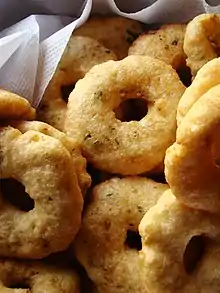 | |
| Alternative names | Uddina vade, Medhu vada, Uddi vada, Minapa garelu, Uzhunnu vada, Udid Vada, Ulundu vadai, Urad vada, Ulundu wade, Urdi bara, Batuk |
|---|---|
| Type | Fritter |
| Course | Breakfast |
| Place of origin | India, Sri Lanka |
| Region or state | South India |
| Serving temperature | Warm (with sambar and coconut chutney) or room temperature (with yogurt) |
| Main ingredients | Urad dal (Split Black gram), Rice |
| Similar dishes | Other vadas, mat pe kyaw |
Etymology
"Medu" is the Kannada and Tamil word for "soft"; "medu vada" thus literally means "soft fritter".[1][4] The dish is often mentioned simply as "vada" on menus.[5]
Other names for the dish include uddina vade (Kannada), urad vada, medhu vadai, ulundu vadai (Tamil), garelu (Telugu), batuk (Nepali),[6] and uzhunnu vada (Malayalam).[7][8]
History
According to Vir Sanghvi, the origin of medu vada can be traced with "some certainty" to the Maddur town in present-day Karnataka. The dish was made popular outside South India by Udupi restaurateurs of Mumbai.[5]
Preparation
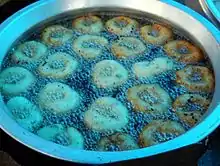
The medu vada is made primarily of black lentils (urad dal) batter.[1] The black lentils are soaked in water for several hours, and then ground to a paste.[1] The paste may be flavoured with other ingredients such as asafoetida, methi seeds (fenugreek), ginger, cumin seeds, black pepper, curry leaves, chillies and coconut pieces.[1] It is then patted into doughnut-shapes and fried in oil until golden brown.[1][2]
One variation involves baking instead of frying.[1] Other variations of the dish involve use of pulses other than black lentils. For example, am-bada (or aama vadai) is made with chana dal (split chickpea lentil); occasionally, tuar (pigeon pea) and masoor (lentil) are also used.[9]
Serving

The dish is usually served with sambar (lentil and vegetable stew) and coconut chutney. Along with idli, it is often eaten as a breakfast. It is also eaten as a lunch starter or a snack.[2][10]
The medu vada is sometimes also served with yogurt, as a chaat snack (see dahi vada).[1]
In Western Nepal, commonly known as batuk or bara, it is considered to be a traditional food of the Magar people. Batuk is never missed out on any festival or family gathering, and is best served alongside pork and kodo-ko-raksi (local alcohol made from millet).[11]
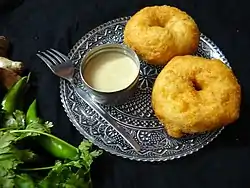 Medu vadas served with coconut chutney
Medu vadas served with coconut chutney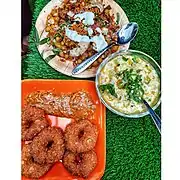 Batuk served with chukauni in a fast food station in Kathmandu
Batuk served with chukauni in a fast food station in Kathmandu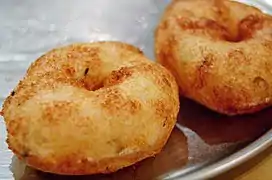 fried Medu vada with chutney
fried Medu vada with chutney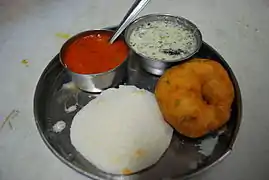 A common South Indian breakfast: idli, medu vada, sambar and coconut chutney
A common South Indian breakfast: idli, medu vada, sambar and coconut chutney
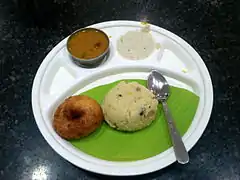 Another common breakfast: medu vada, pongal, sambar and coconut chutney
Another common breakfast: medu vada, pongal, sambar and coconut chutney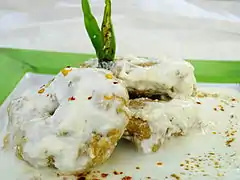 In form of dahi vada, with yogurt
In form of dahi vada, with yogurt
See also
References
- Richa Hingle (2015). Vegan Richa's Indian Kitchen: Traditional and Creative Recipes for the Home Cook. Andrews McMeel. p. pt122. ISBN 9781941252109.
- Meher Mirza (15 December 2015). "The Star of South India: Medu Vada in its Many Avatars". NDTV.
- Hingle, R. (2015). Vegan Richa's Indian Kitchen: Traditional and Creative Recipes for the Home Cook. Vegan Heritage Press, LLC. p. pt79. ISBN 978-1-941252-10-9.
- Alevur Sriramana Acharya (1971). Barkur Kannada. Deccan College. p. 4.
- Vir Sanghvi (2004). Rude Food: The Collected Food Writings of Vir Sanghvi. Penguin India. pp. 110–111. ISBN 9780143031390.
- https://www.thegundruk.com/batuk-roti-made-from-black-lentils/
- Siva Sadasivan (2015). Riding God's Axe. Leadstart. p. 21. ISBN 9789352013609.
- Alamelu Vairavan (2010). Chettinad kitchen. Westland. p. 30. ISBN 9789380283883.
- K. T. Achaya (1994). Indian Food: A Historical Companion. Oxford University Press. p. 127. ISBN 978-0-19-563448-8.
- "Recipe: Medu vada". The Times of India. 22 May 2015.
- "BATUK A MAGAR DELICACY".
External links
| Wikimedia Commons has media related to Medu Vada. |
| Wikibooks Cookbook has a recipe/module on |